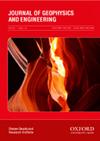Efficient pure qP-wave simulation and reverse time migration imaging for vertical transverse isotropic (VTI) media
IF 1.7
3区 地球科学
Q3 GEOCHEMISTRY & GEOPHYSICS
引用次数: 0
Abstract
Anisotropic pseudo-acoustic forward modeling and migration imaging are critical for high-precision seismic exploration. However, the wavefields simulated by the traditional coupled anisotropic acoustic wave equation have the problems of shear wave noise and numerical simulation instability for epsilon that is less than delta. Furthermore, although the pure anisotropic acoustic wave equation expressed by the differential operators can solve the aforementioned noise interference and numerical simulation instability issues, its numerical simulation calculation is large, particularly in 3D industrial applications, because it has to be solved by the spectral-based method. In this paper, a pure anisotropic acoustic wave equation in a vertical transverse isotropic (VTI) medium that can be numerically computed using the efficient finite difference method is derived. This equation not only eliminates noise interference and numerical simulation instabilities, but also allows for efficient wavefield simulation. We also implement reverse time migration (RTM) using the proposed VTI pure anisotropic acoustic wave equation. Two synthetic tests and one field data test are performed to evaluate the accuracy and robustness of the developed VTI RTM. The imaging results show that the proposed VTI RTM can correct the anisotropy effect on seismic wave propagation and improve migration imaging precision.垂直-横向各向同性(VTI)介质的高效纯qP波模拟和逆时偏移成像
各向异性伪声学正演建模和偏移成像是高精度地震勘探的关键。然而,传统的各向异性耦合声波方程模拟的波场存在剪切波噪声和小于delta的ε的数值模拟不稳定性问题。此外,尽管由微分算子表示的纯各向异性声波方程可以解决上述噪声干扰和数值模拟不稳定性问题,但其数值模拟计算量很大,特别是在3D工业应用中,因为它必须通过基于谱的方法来解算。本文推导了垂直-横向各向同性(VTI)介质中的纯各向异性声波方程,该方程可以用有效的有限差分法进行数值计算。该方程不仅消除了噪声干扰和数值模拟的不稳定性,而且允许有效的波场模拟。我们还使用所提出的VTI纯各向异性声波方程实现了反向时间偏移(RTM)。进行了两次合成测试和一次现场数据测试,以评估所开发的VTI RTM的准确性和稳健性。成像结果表明,所提出的VTI RTM可以校正地震波传播的各向异性效应,提高偏移成像精度。
本文章由计算机程序翻译,如有差异,请以英文原文为准。
求助全文
约1分钟内获得全文
求助全文
来源期刊

Journal of Geophysics and Engineering
工程技术-地球化学与地球物理
CiteScore
2.50
自引率
21.40%
发文量
87
审稿时长
4 months
期刊介绍:
Journal of Geophysics and Engineering aims to promote research and developments in geophysics and related areas of engineering. It has a predominantly applied science and engineering focus, but solicits and accepts high-quality contributions in all earth-physics disciplines, including geodynamics, natural and controlled-source seismology, oil, gas and mineral exploration, petrophysics and reservoir geophysics. The journal covers those aspects of engineering that are closely related to geophysics, or on the targets and problems that geophysics addresses. Typically, this is engineering focused on the subsurface, particularly petroleum engineering, rock mechanics, geophysical software engineering, drilling technology, remote sensing, instrumentation and sensor design.
 求助内容:
求助内容: 应助结果提醒方式:
应助结果提醒方式:


